Finding Your Brand's Voice: 0-100% in 5 SIMPLE STEPS!
People in branding often consider how a brand appears aesthetically, from typefaces to colours to design styles. Brand voice is something that is frequently disregarded. With the advent of social media in marketing efforts, brand voice is more crucial than ever as a method to stand out in a sea of digital noise.
Even if you are unfamiliar with the term, you have very certainly encountered it. The corporation that sells surf gear adopts a surfer's terminology and attitude. To connect with its target group, the tween clothes brand loosens up its wording and employs popular slang. While you may get away without having a distinct brand voice, having one allows you to push your marketing far further.
So, without further ado, let’s do further and see what exactly your brand voice means and how you can go about developing your very uniquely own brand voice!

Tone of Voice
The tone of voice characterises how your brand communicates with its audience and, as a result, determines how people interpret your messaging. In other words, it specifies how we want to communicate to our audience rather than what we want to say to them.
The tone of voice used by your firm shows the personality and values of your brand. This includes the words you use and the sequence in which they are placed, and it applies to all content you offer – website content, social media postings, emails, and any other formats.
The words and phrases you choose when speaking, as well as how you organise your sentences, all contribute to your written tone of voice. Using direct, second-person pronouns (such as "you") and short, casual words, for example, can generate a pleasant and inviting tone.
Because different reasons necessitate different means, your tone of voice may change from time to time, based on the audience with whom you communicate, the media and content formats you employ, and the ultimate result you seek. Even if certain situational alterations are required, your overall tone of voice should be consistent across whatever information you offer.
Brand Voice
You might be thinking that “this Tone of Voice thing would be your brand’s voice then, right?” Well, while they are linked (and share the word “Brand”), brand voice and tone serve two distinct functions:
Brand Voice expresses your brand's distinct point of view as well as the values you stand for. In other words, this is the entire personality of your brand.
Brand Tone of Voice refers to how your brand communicates with its audience, including the language used, communication style, and emotional tone. This can vary depending on what is most suited for the situation at hand.
To use yourself as an example, you have a distinct perspective and personality that remains virtually consistent throughout all of your day-to-day interactions. However, the manner you communicate with others in each of those situations may differ.
When speaking to your employer, you usually adopt a different tone and wording than when writing a research paper or chatting with close friends in a relaxed situation. Similarly, your brand voice should be constant, even if you need to modify your tone of voice to fit a certain piece of content.

Why Voice is Vital
The tone of your voice can have a significant impact on your relationship with your audience, brand identification, and even overall performance:
-
It establishes a bond with your audience and stimulates debate. 65% of customers say they are emotionally attached to a brand in such a way that they believe the firm cares about them. A caring or friendly attitude toward your audience can encourage them to interact with you more, providing you with the opportunity to solve their concerns.
-
It fosters trust among your target audience. Trust can be created through a variety of methods; in one survey, 81% of respondents said it was important to them to buy from businesses that match their values. To help you achieve this goal, highlight your humanitarian efforts, donations, and major workplace events.
-
It generates an unforgettable image of your company and its personnel. However, the perception of your brand is influenced by more than just the language employed – essential colours boost brand recognition by up to 80%. This is especially critical for small or start-up businesses where content is developed without the assistance of a designer.
If this data has persuaded you that your firm needs a tone of voice and you are keen to define how to represent your brand personality, read on to find out who is capable of establishing a tone of voice and how to do so step by step.
Finding your Voice
In general, there is no specific job in every organisation that specialises in a tone of voice. Who is in charge of it is mostly determined by your team's experience and areas of need? It is critical to engage people who have a thorough awareness of your brand's culture and values, as well as a thorough understanding of your customers and the competitive landscape.
To determine your brand's tone of voice, you must:
-
Recognise your target audience.
-
Choose the appropriate language to communicate with them.
-
Determine the values and characteristics of your brand that you wish to translate.
Let's go a little deeper and look at each step you'll need to take.
❶ Knowing Your Audience

To understand how to approach your audience and offer relevant information, you must conduct thorough research on your clients and tailor your content to their profiles. Speaking of customer profiles, if you haven’t built yours yet, feel free to read through our article on that very topic right here.
Research
Learn about their gender, age, interests, education, and work title – everything you can get your hands on. Investigate their demographic information using Google Analytics and social media analytics.
Then, using this information, create a portrait of your persona. Remember that your audience may comprise everyone from loyal customers to possible future customers who are discovering you for the first time.
Tip: Considering the generations, you're speaking to can help you relate more effectively when it comes to tone of voice. While each generation has many similarities, their individual experiences have a significant impact on how they interact.
For example, many Baby Boomers are now retired — or will be soon — and have integrated digital technology into their daily life. They're into everything now that they're back home, from cellphones to health and wellness wearables to gaming and esports. They also spend a lot of time on Facebook and are 19% more likely to be influenced by internet advertising than other generations.
Because of digital fatigue, Generation X is particularly interested in outdoor activities and pastimes. One of the primary topics for this generation is the value of "Me Time," which allows them to unwind from demanding work and family life. They also hunt for bargains, enjoy cooking, and set trends in the skincare and beauty industries.
Millennials are also very active social media users, where they connect with interests such as home, wellness, and, of course, their beloved dogs to escape the stress of daily life. They appreciate equality as a generation, particularly in family and domestic matters, which influences their engagement and purchasing decisions.
Gen Z, like millennials, is motivated by shared values. They are concerned about topics such as climate change, possibly as a result of the uncertainty that has coloured their young adult years. They want the government, as well as the organisations they work with, to demonstrate a commitment to fixing those concerns. They, like millennials, seek escapism-nostalgia, enjoying things like vinyl albums, 90's clothes, cassette tapes, and more.
One thing to remember is that, in general, each generation reacts to the one before it. For example, because the internet was still relatively new to many Millenials, they embraced it enthusiastically – hence their ongoing excitement for email and social media. Gen Z, on the other hand, grew up with the internet as a given. That is, they assert themselves to some extent by "disconnecting" and seeking out distinctive in-person encounters. They primarily use social media to express their identities by sharing their experiences.
Find Out What They're Reading

When you've built your character, find out what platforms they prefer to communicate with brands to better modify your tone of voice - do some credible online research.
Continuing on the issue of generations, a Data Axle white paper on marketing to each consumer generation states,
-
Email and social media, notably Facebook, Twitter, and Instagram, are important to millennials. They are loyal to brands because of individualised, cross-channel brand experiences, brand ideology, and loyalty benefits.
-
Generation Z prefers mobile apps to email and social media, as well as authentic, individualised brand experiences and high-quality products and services. While they enjoy in-store experiences, it is equally critical to contact them through their preferred social media channels, which include Facebook, Instagram, Snapchat, and, increasingly, TikTok (according to Forbes). You may also look at your genuine consumers' social profiles to see what resources and companies they follow.
You may also look at your genuine consumers' social profiles to see what resources and companies they follow.
Your goal is to find the most reputable sites and top social media pages where your target audience discusses industry-related topics. Find top forums discussing your industry terms and your brand with an automated tool like Brand Monitoring.
Remember that social media material is not one-size-fits-all. To be successful, each piece you share should be suited to the demands of that platform as well as the interests of the audience you're targeting.
Glossier, for example, focuses on cultivating a community of young, like-minded beauty aficionados, which has inspired not only their content approach but also their Instagram-friendly packaging and general look. Here's one example of how they go about it.
This Instagram post combines Millennial interest in wellness and self-care with Gen Z's aspirational, experiential attitude, while also appealing to the visual element of the Instagram platform:
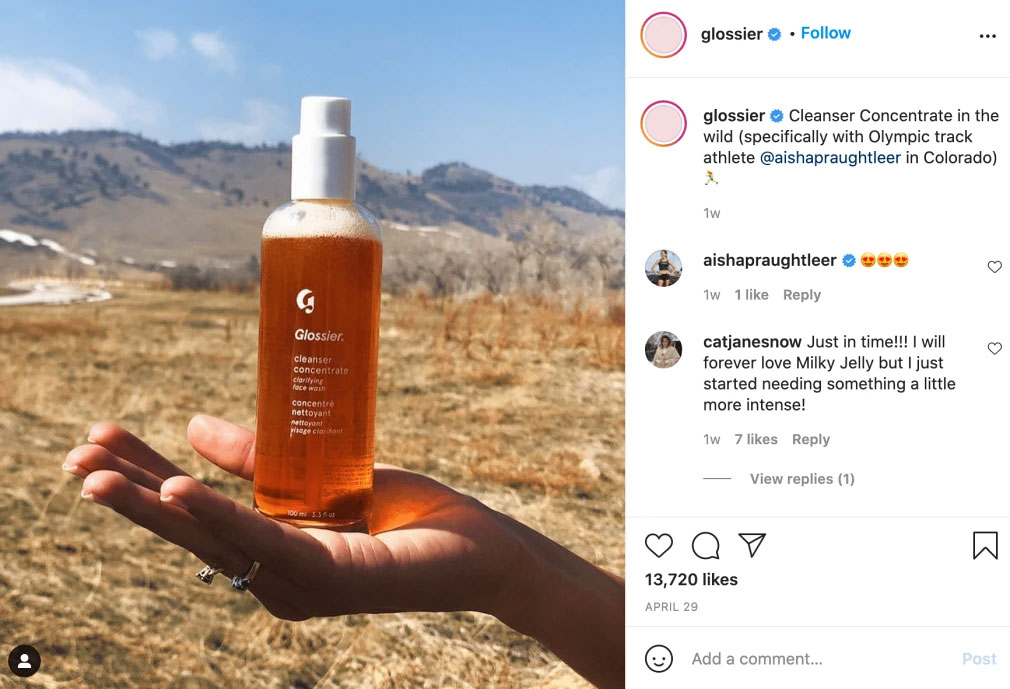
Source: Glossier Instagram
Take Note Of How They Interact With Each Other
Next, go into these materials — and research thoroughly. Take note of how your target audience communicates with their peers, what they like and dislike in discussion threads, the overall tone of debates, and the language used to create the most popular material.
According to experts, imitating a specific group's communication patterns, tone, and body language encourage members to feel a sense of belonging. Making your material more relatable by mimicking how your audience speaks. If done correctly, this can potentially increase sales.
Empathy is also becoming more crucial. People, especially in times of crisis, want to know that you understand them as well as your tone and motive.
Don't be scared to address your audience on their level. Engaging your audience's interests, even if they don't instantly line up with your product or brand, may be a terrific approach to demonstrate the lighter side of your business's personality and develop a relationship.
Consider this inventive Star Wars Day post from Arby's:

Source: Arby’s Twitter
It not only appeals to a popular cultural touchstone, but it also puts a creative spin on an annual meme ("May the Fourth Be With You") popular with the millennials they're aiming for.
Some brands prefer to engage with their audience more directly, encouraging them to share their unique work and celebrating their successes on their platform.
Consider this Newegg Twitter tweet, which celebrates a user's bespoke PC build:
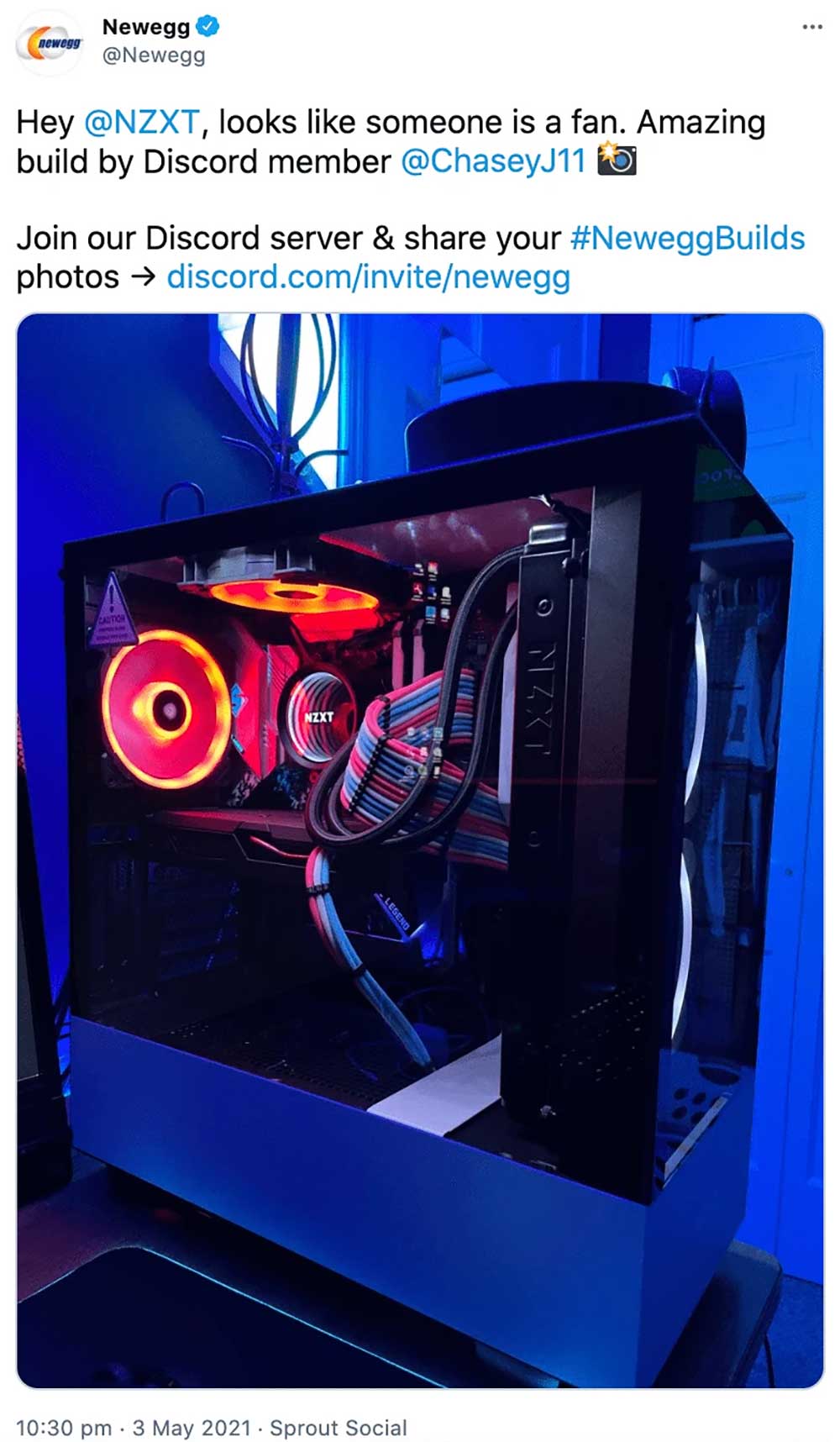
Source: Newegg Twitter
Get Customers To Tell What They Think About You
Traditional market research methods, such as customer surveys or interviews, are excellent for gathering feedback from people who are already familiar with your business. If you haven't yet defined your tone of voice guide, that doesn't mean your brand lacks personality.
Inquire about your clients' perceptions of your brand and what events or content pieces have influenced this perception. Here are some questions you can ask them:
-
In three words, how would you characterise our brand?
-
What kind of person would our brand be if it were a human?
-
What piece of content/email/tweet from our brand best represents us?
Keep the descriptions you receive for the time being; we'll come to them in the third phase.
❷ What Are Your Brand’s Values?
Define the main aim of your communication before deciding what to write. This should be guided by your organisation's basic principles.
Identifying your core principles will assist you not only in finding the language required to properly deliver your message but also in shaping the community surrounding your business and ensuring that you connect with your customers.
Defining Your Core Values
Transparency is essential for establishing confidence with your consumers. 95% of consumers polled indicated they were more likely to be loyal to a company they trusted, and 92% said they were more likely to purchase more items or services.
Begin by completing the following questions to determine your basic values:
-
Why was the company founded?
-
What distinguishes your brand?
-
What does your brand stand for?
-
What ideals do you wish to communicate to your audience?
There are no perfect templates for outlining them, but you can learn from others – here is an outstanding example of a Zappos core values statement; this allows both staff and consumers to know what to expect when working with Zappos.
While many businesses disclose their basic principles on their websites, it is not required of you. You may instead save this for internal use exclusively if you like.
Mission Statement
After you've determined your brand values, write a short brand mission statement for your target audience. Show your audience who you are, what you care about, and how your brand can assist them. You can also describe what your organisation does to help its employees.
Keep in mind that your entire team must function following these ideals.
A well-defined mission statement builds the culture of your business and allows your audience to relate to your firm, particularly if those values are shared.
Message Architecture
A message architecture guides exactly what we say to keep your communication aligned.
A message architecture is a series of terms, phrases, or statements that describes a brand's prioritised communication goals. Its primary purpose is to enable all content creators in an organisation to convey consistent messaging across all content kinds.
Margot Bloomstein, Brand & Strategy Consultant and an early proponent of the phrase, offers suggestions on how to create a message architecture.
Compile a list of up to 50-100 adjectives relevant to your industry (or use one from her book), gather your stakeholders, and divide them into three groups:
-
What we stand for.
-
Who we aspire to be.
-
What we aren't.
Concentrate on the "Who we'd like to be" column, then sort your descriptors into affinities and prioritise them. You can then add sub-bullets and colour coding as needed to assist clarify their meanings. Finally, include your finalised message architecture in your content strategy.
A message architecture is not the same as a brand voice chart, but it should be used in conjunction with one. It describes what we want to say to our audience rather than how we want to say it.
Remember that a message architecture is not a glossary of words to utilise in your content, but rather prioritised reference points for your team to select what to express to represent your organisation's messaging priorities.
Ensure that your message architecture is distributed to all content creators in your organisation as well as all people involved in content development.
❸ Content Audit
Audit your existing material and communication to understand what your brand sounds like right now before designing a tone of voice that fits your organisation.
To do so, establish a list of your greatest (in your opinion) and top-performing (according to your content metrics) content pieces, and ask yourself if your present tone of voice:
-
Does it correspond to the brand values you want to communicate?
-
Does it reflect your mission statement's ideals for your target audience?
-
Does this correspond to your message architecture?
Go through each piece of material and record (e.g., in a spreadsheet) how your brand sounds. Nielsen Norman Group defined four dimensions of the tone of voice to assist content strategists and other specialists in analysing a website's tone of voice:
-
Serious vs. Funny
-
Formal vs. Informal
-
Irreverent vs. Respectful
-
Enthusiastic vs. Objective
Make use of the SEO Writing Assistant to ensure that each of your content assets adheres to the formal or casual tone of voice. A machine-learning system and hundreds of human-rated text pieces enable the tone of voice to function.
Look at each of the four dimensions to see where your brand's tone of voice falls the most.
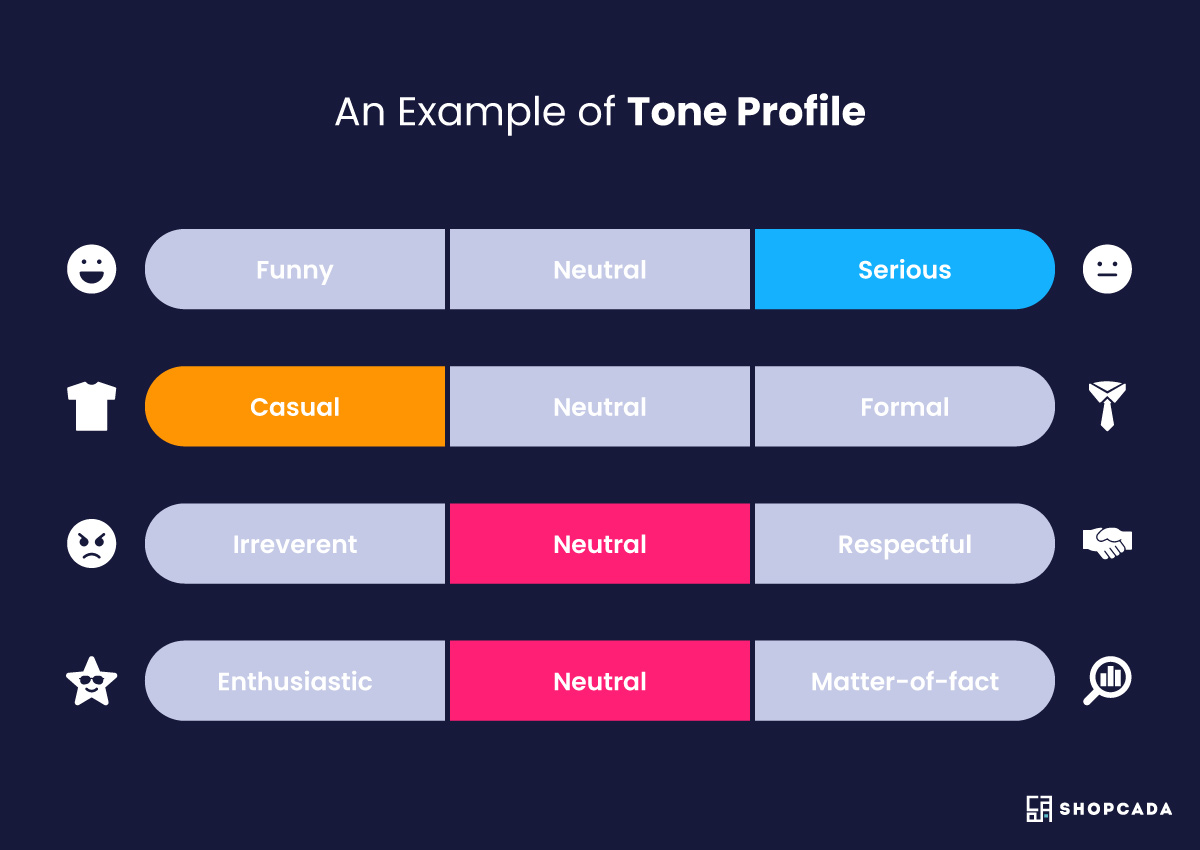
Tip: Review how your customers characterised your brand in the interviews/surveys and see how their descriptions fit with yours. Include their qualities in your findings if it does not.\
This visualisation will show you how your brand sounds right now and will assist you in getting closer to the way you want to sound following your brand values.
❹ Define it!
We've finally arrived at the stage where you take all of the research data — your audience portrait and brand values — and use it to define your brand's tone of voice.
The tone of voice should handle two issues:
- How you sound.
- How you want to be heard.
You can then use the Nielsen Norman Group's dimensions to determine not only what you want your brand to sound like, but also what you don't want it to sound like. You may then use that data to fine-tune your new tone and produce a brand voice chart.
Continue reading to learn about each tone of voice dimension and to see how different organisations' tones of speech are demonstrated via their personalised 404 pages.
Determine Your Tone
Pro-tip right off the bat: Tones that are easygoing, conversational, and modestly enthusiastic perform best.
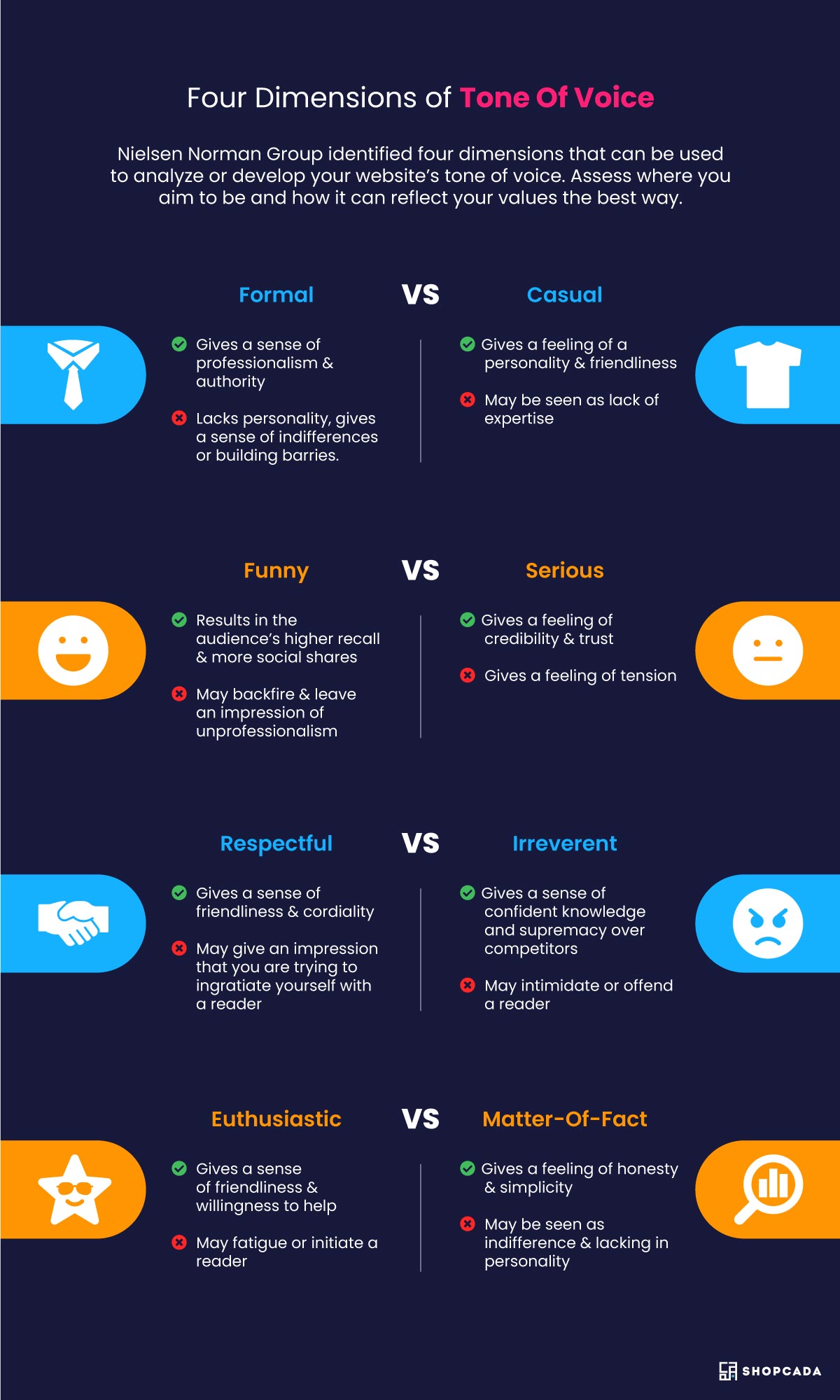
Formal v Casual
Choosing your chosen level of formality is critical since it influences how buyers perceive your brand. Using overly formal language, for example, can help you appear more authoritative, but it can also feel impersonal.
Casual language, on the other hand, can serve to generate a sense of personality and friendliness, but being too casual in the wrong situation might make you appear inexperienced or unprofessional.
According to surveys, 65% of customers preferred a casual tone from their support workers during encounters. According to Jay Ivey, an analyst at Software Advice, this also depends on the context - 78% of clients would be upset if their request was declined in a casual tone. In comparison, only 35% stated it decreased their happiness if a request was approved in a formal tone. According to the researchers, this is due to a casual attitude being seen as condescending or insensitive in specific settings.
The Alfa Romeo brand combines rational and emotive elements. Their brand voice, on the other hand, is more official than informal. Here's an example of their 404 page, which explains why an issue occurred in detail in the formal passive voice:
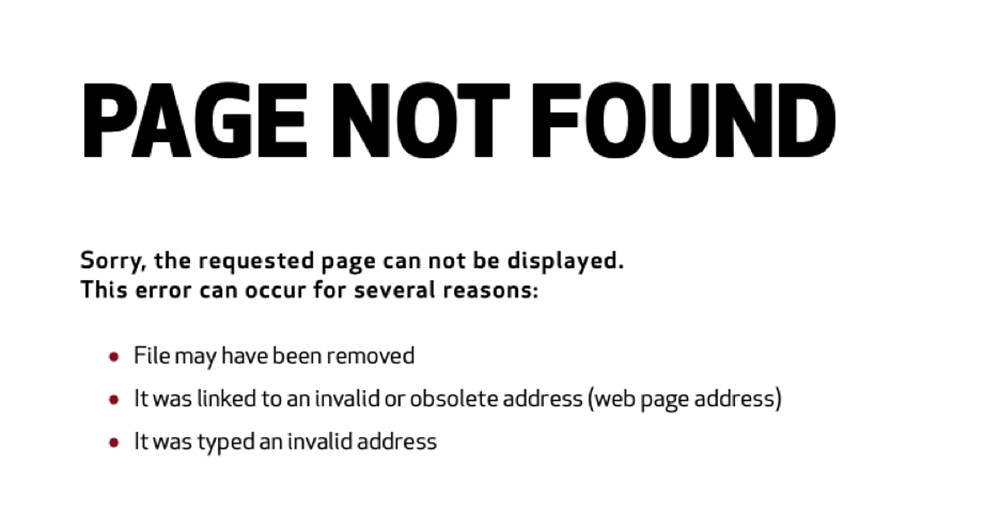
Source: Alfa Romeo
Mini, on the other hand, is direct, real, and engaging. In contrast to Aston Martin, they utilise an energetic voice and add a romantic touch to their 404 page, which casually expresses their personality:
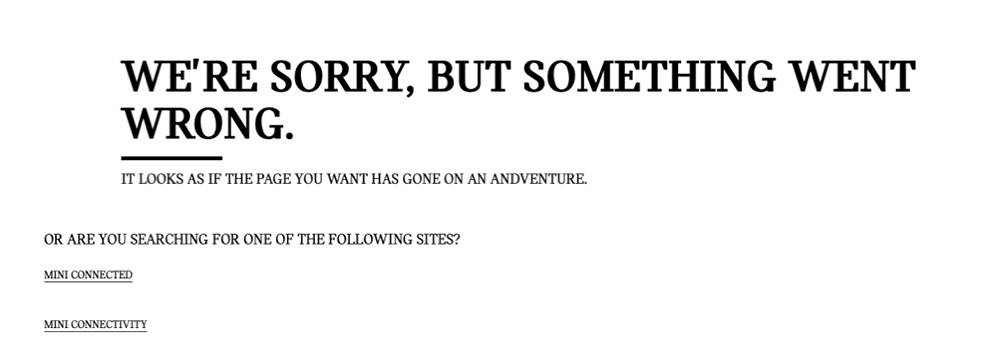
Source: Mini
Funny v Serious
Humour can boost memory recall and increase shares, allowing you to stand out from competitors - as long as your audience finds you amusing. However, in brand communication, humour is always a risk that can backfire. When used incorrectly, it might alienate your users, give the impression of a lack of seriousness, and, as a result, unprofessionalism.
Introducing a more serious tone will aid in the development of credibility and trust. However, serious language may lack individuality and emotions, and even creates tension.
When deciding between a humorous and serious tone, keep in mind that a humorous tone will not suit all organisations, and, more importantly, humour should not come in the way of really engaging with your audience.
Mailchimp is a well-known brand that doesn't take itself too seriously. They use odd humour and a conversational voice in all of their brand communication, including their 404 page:
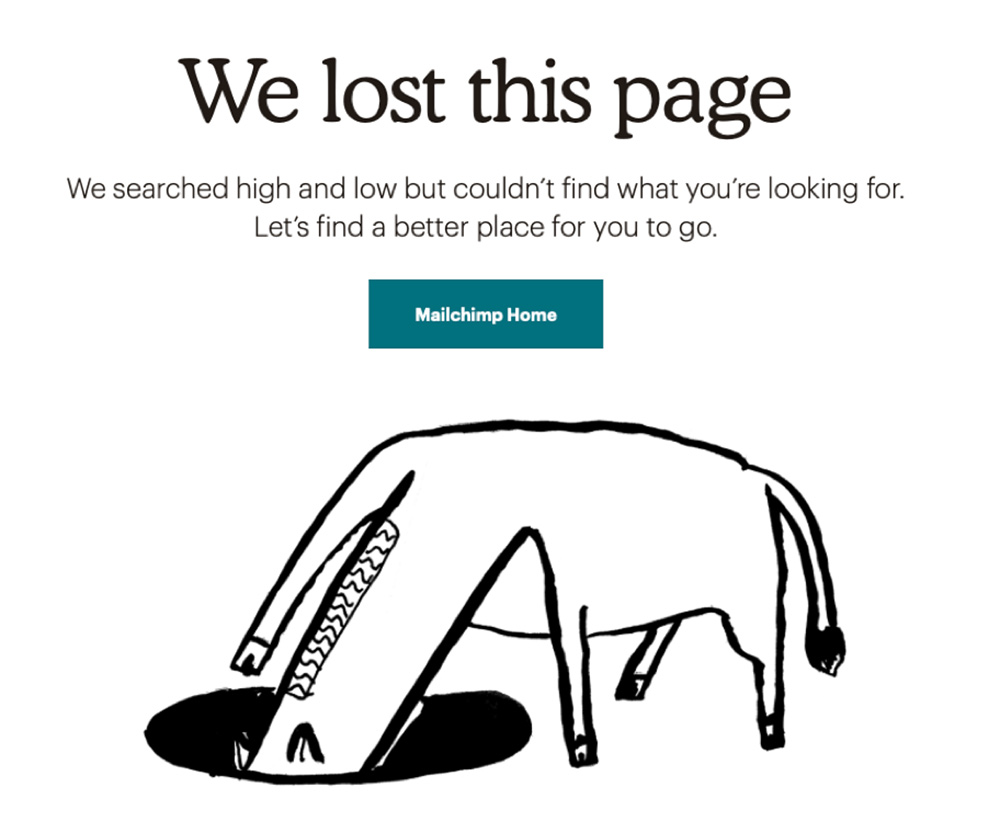
Source: Mailchimp
SendinBlue, on the other hand, is positioned more seriously, despite the fact that they both provide essentially comparable services. Their 404 page is drastically different from Mailchimp's and lacks any sense of humour:

Source: SendinBlue
Respectful v Irreverent
Respectful language conveys kindness and cordiality. However, an overly courteous tone, particularly when used inappropriately, may convey the impression that you are attempting to ingratiate yourself with the reader.
An irreverent tone makes your brand appear strong and authoritative and even gives the impression of superiority over the competition. Irreverent language, on the other hand, can scare or insult a reader.
Dollar Shave Club is a great example of a well-executed irreverent and disruptive marketing voice. This is perfectly illustrated by Dollar Shave Club's personalised 404 page, which includes a gif and an invitation to purchase some of their products.

Source: Dollar Shave Club
Gillette, on the other hand, tends to speak properly and with a caring voice when addressing its audience, as evidenced by its 404 page, which states that it is Gillette's responsibility to solve it.
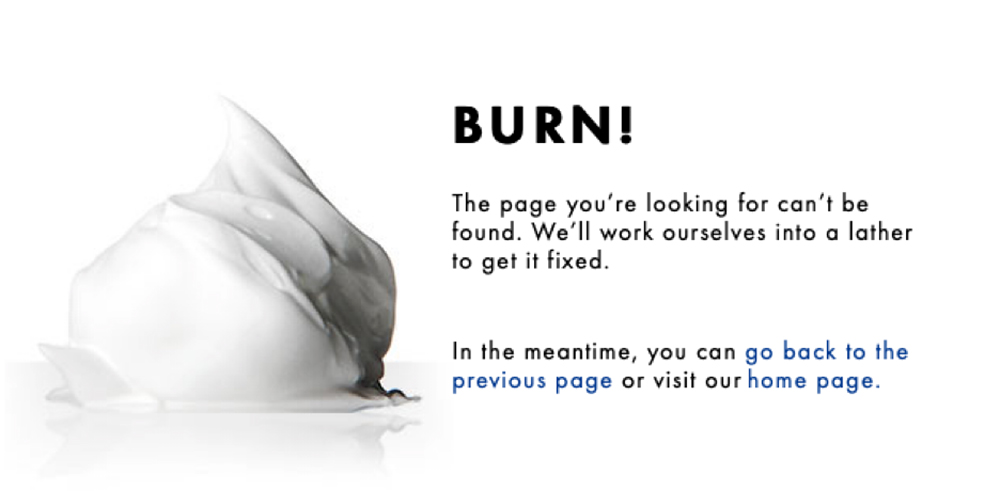
Source: Gillete
Enthusiastic v Matter-of-Fact
A passionate tone conveys friendliness and helpfulness, but when used inappropriately, it can bore or irritate a reader.
The use of matter-of-fact language conveys an air of honesty and simplicity. However, if not executed well, it may be perceived as disinterested or lacking in individuality.
Taco Garage has a straightforward approach, delivering "real tacos for real people that taste really good." Their tone of voice is basic and straightforward, and their 404 page is no exception.

Source: Taco Garage
Taco Bell's brand voice, on the other hand, is energetic, adventurous, hilarious, and incredibly inventive. To get a sense of their personality, visit their 404 page.
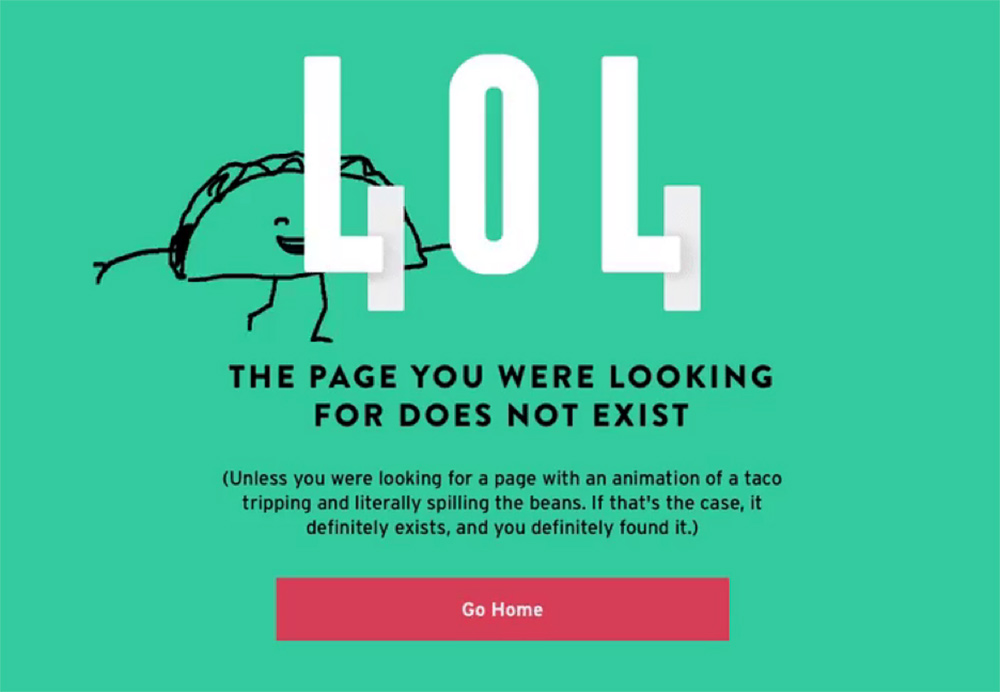
Source: Taco Bell
Refine It Further!
After determining where your brand fits under each dimension, refine it by selecting more particular tone qualities, such as "playful," "quirky," or "sarcastic."
You can utilise the Norman Nielsen Group's list of 37 tone-of-voice terms for this. This list has been divided into four dimensions for your convenience. You can, however, assign some of these terms to another dimension or use any other phrases to characterise your brand.
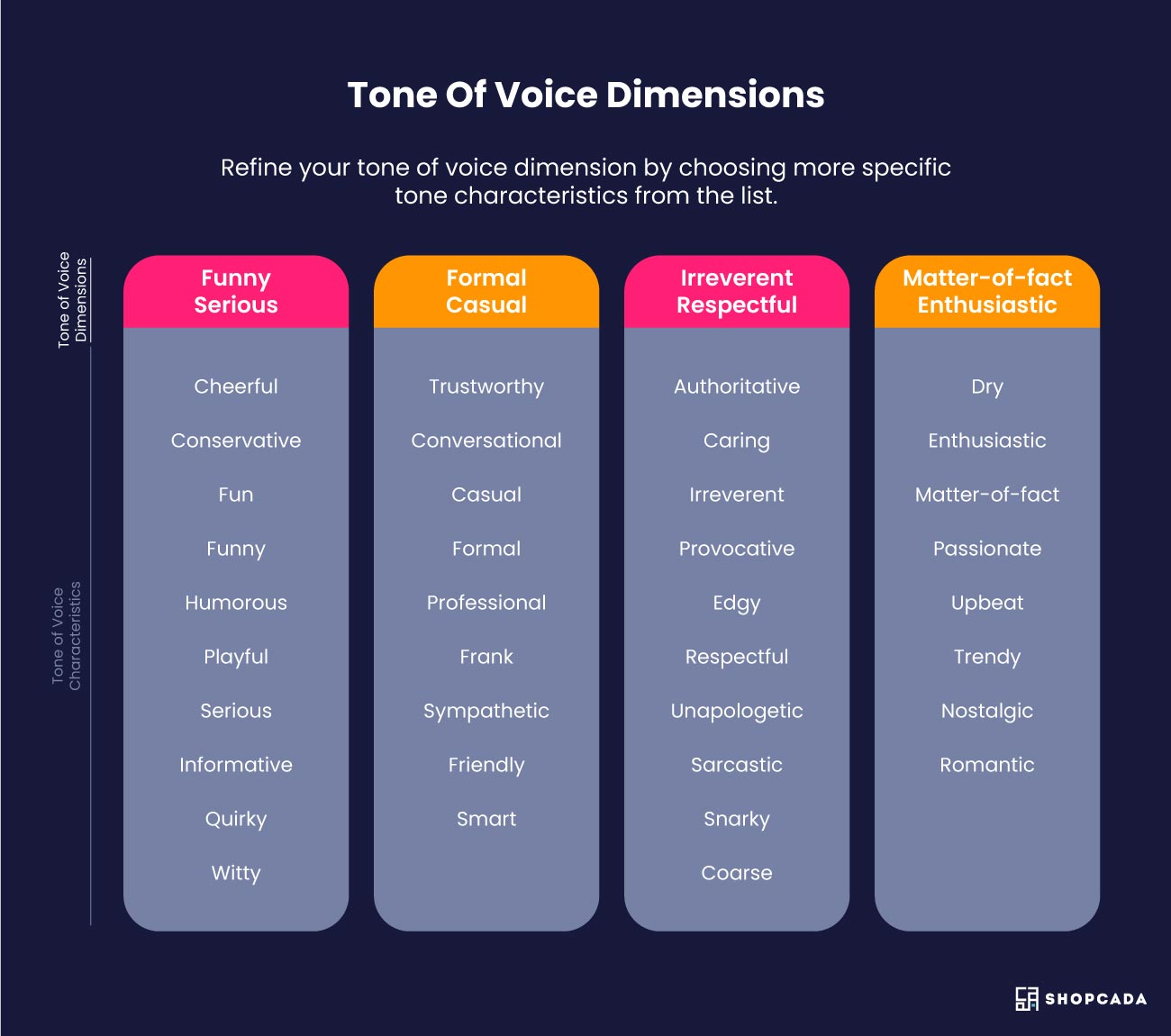
Once you've identified and refined your preferred tone of voice, combine "How we sound" with "How we wish to sound." Check to see if you have any competing ideas and try to reconcile them.
Brand Tone Of Voice Charts
Using the CMI template below, combine all voice qualities into a single chart, define each one in-depth, and provide examples of how you may create a unique voice. The important element here is to demonstrate what you should avoid.
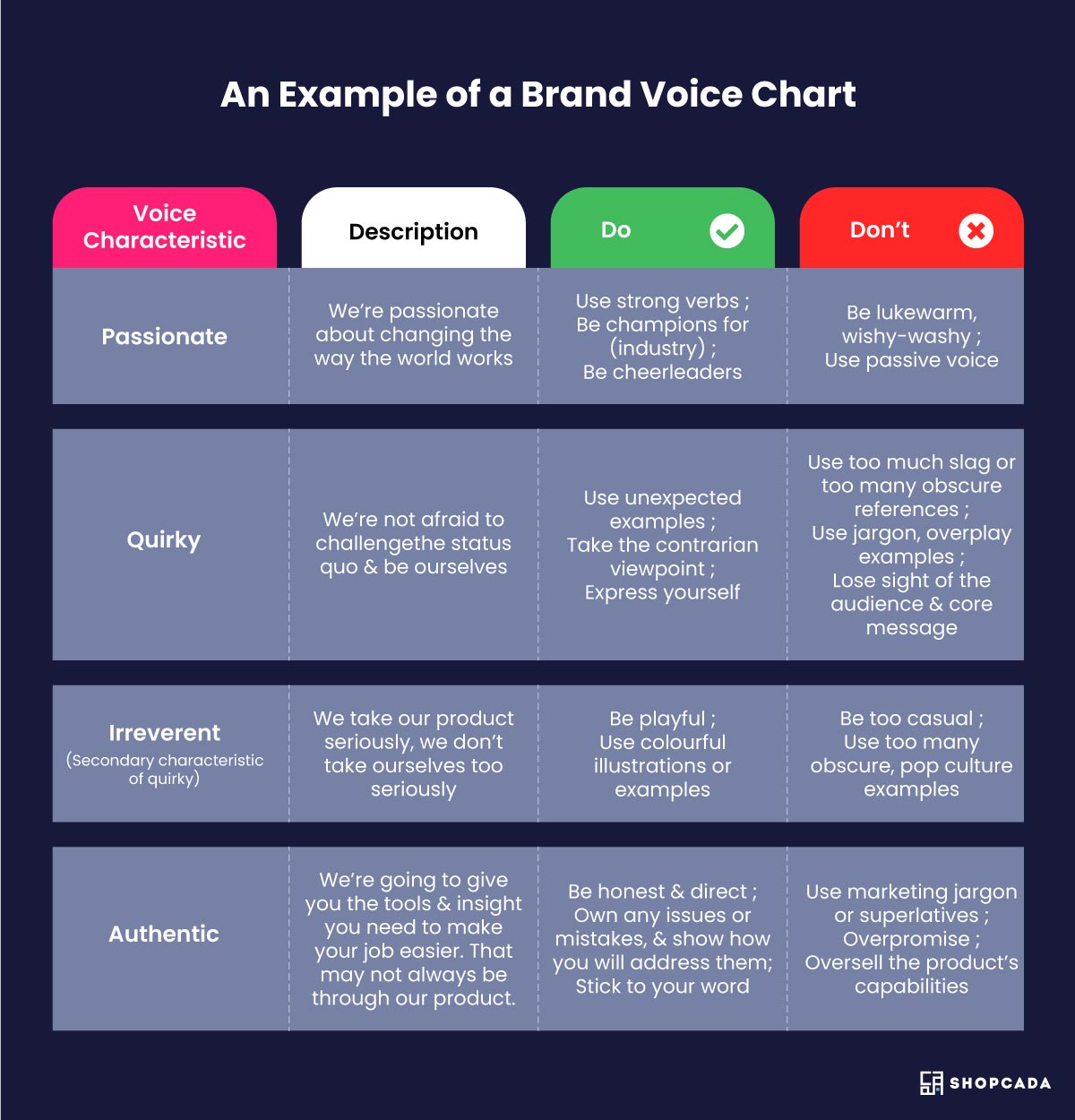
If you need assistance in this area, consult with writers on how to represent your voice qualities verbally.
The next stage is to develop a brand's tone of voice rules, share them with your content team, and verify that they are followed in all forms of communication.
❺ Incorporate Tone Of Voice Into Brand Communication
To successfully apply your tone of voice, start by creating clear brand rules that are reviewed regularly, especially when your positioning or target audience changes.
Create Tone Of Voice Guidelines For Your Company
People gain confidence in writing in this new style by following clear standards, norms, and good examples. Although many brands have them, just one-fourth have explicit criteria that are consistently followed.
Begin by writing your rules in the tone of voice you've created for your business - this will be a wonderful example of how to use it correctly when writing.
Include some examples of the tone of voice to strive for in each item to ensure the standards are straightforward for team members to follow. Furthermore, instances of the wrong tone of voice will help authors understand what not to do.
Your internal policies should include the following:
-
A profile of your target audience, including their voice,
-
The attitude of your brand toward your target demographic (a best friend, an aunt, a teacher, etc.),
-
The core values of your brand,
-
Your company's mission statement,
-
Your message structure,
-
Your brand voice profile,
-
Particular vocabulary and grammar rules,
-
Clear instances in many circumstances.
Establishing particular language and grammar guidelines, coupled with examples of what you mean, can help content authors understand your brand and tone of voice, and can even help the editorial process run more easily.
Here are some examples of vocabulary and grammar rules to think about:
-
Grammar and punctuation: How strictly do you wish to follow grammar rules? If you use a certain style guide (such as AP Style or Chicago Style), now is the moment to mention it. Can your writers defy the norms, for example, by utilising sentence fragments or double negatives for emphasis or humour, as is common in casual speech? If you're working with authors from all over the world (for example, speakers of US and UK English), you should indicate the spelling and grammar norms you'll use.
-
Slang and swearing: If you do have a more casual tone, can you use current slang and swear? Slang and profanity may not be appropriate for every business or audience, and even if they are, it is a good idea to create standards for what is and is not allowed, as well as why. (For example, your brand may determine that it is acceptable to use certain swear words but not others because they violate your brand's principles.)
-
Technical language: Highly technical language is often appropriate, especially if your audience is made up of seasoned professionals who also communicate in this manner. On the other hand, if you're primarily speaking to casual consumers who don't have that degree of related technical understanding, keeping things simple is preferable.
-
Pronouns: When writing for a broad audience, it's crucial to define pronouns. Is it acceptable to write in the second person, to your audience (using words like "you")? If acceptable for your brand, this might help to establish a more personable, relaxed tone. If you want to keep things more official, confine writers to the third person (using "he," "she," or "them" pronouns rather than "I" or "you").
Keep in mind that your tone of voice should be consistent throughout your message.
Assign one team member, such as an editor or content manager, responsibility for implementing the requirements. This will assist in ensuring that all of your brand's communications employ the appropriate language to convey the appropriate tone in all of its deliverables.
Closing Words
Defining your brand's tone of voice and establishing clear rules will assist that tone shine through in every piece of content. This is an important step in creating a content strategy that is true to your goal and appears genuine to customers.
You can establish a vision of what your business wants to say and how to use the correct language to get this message across if you know where your audience resides online and what topics they want to hear more about.
Maintaining a consistent tone throughout all of your interactions will help your audience understand what the brand stands for and what characteristics you share with your target demographic.

